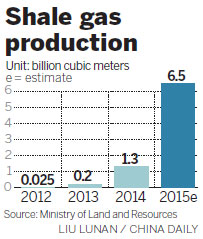




First phase of key project starts in Sichuan Basin of southwest China
China Petrochemical Corp is planning to boost shale gas output capacity at its Fuling project to 10 billion cubic meters by 2017.
Sinopec says that the first phase of the Fuling shale gas project in the Sichuan Basin of Southwest China has commenced production with an annual capacity of 5 billion cubic meters.
The project, China's largest shale gas project to date, is the latest sign that China's shale gas sector is revving up as the country seeks to optimize its energy use to reduce emissions.

"The fruits that we achieved have given us huge confidence. The extraction and exploration model in Fuling can be duplicated and promoted in many other places," he says.
Though China has rich shale gas resources, high extraction costs, lack of advanced drilling techniques and a complicated terrain have hindered development.
But the country is taking huge steps toward tapping its shale gas potential with more localization of key equipment and steps to cut carbon footprint and the excessive reliance on coal.
The costs of drilling a single shale gas well have fallen by 20 percent from a year ago in China, Jiao says.
Due to the complex geographic structure in the Sichuan Basin area, the company is facing more challenges in drilling gas from below the ground than its peers in North America.
The average depth of the wells in Fuling is between 2,400 meters and 2,800 meters, while in North America, most wells are less than 2,000 meters deep, Huang says.
The current daily production at the Fuling site, which has 380.6 trillion cubic meters of proven shale gas geological reserves, is enough to meet the daily needs of 32 million residents.
Currently China's natural gas accounts for a mere 5.5 percent of primary energy consumption, much lower than the world's average natural gas consumption of about 24 percent in the energy mix.
Source: European Weekly